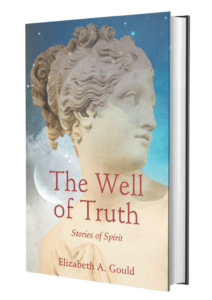 Author Elizabeth A. Gould is here today and we’re chatting about her new women’s fiction, The Well of Truth: Stories of Spirit. It’s a novel of the feminine experience, and is filled with reflections on feminine resilience, power, and agency.
Author Elizabeth A. Gould is here today and we’re chatting about her new women’s fiction, The Well of Truth: Stories of Spirit. It’s a novel of the feminine experience, and is filled with reflections on feminine resilience, power, and agency.
Bio:
Elizabeth Gould received a BA in Art History from Stanford University and worked for several years in the Old Masters art world in New York City before she obtained an MS in Education from the State University of New York. As an elementary school teacher, she found her passion in mentoring girls at puberty and working with their families to better understand this important rite of passage. For many years, she was the director of a non-profit dedicated to positive menstrual/menopausal education and awareness.
The themes in The Well of Truth grew organically out of her decades of experience as a mother, art historian, teacher, and menstrual advocate. The stories incorporate her love of travel, mythology, goddess traditions, trees, and the moon. Although she is a California native, Elizabeth feels most at home in Aotearoa, NZ. The Well of Truth is her first book.
Please tell us about your current release.
The Well of Truth is the story of a woman on a journey of self-discovery. Through the telling of significant moments in her adult life, the heroine, Grace, garners insight and inspiration from mythic figures who skillfully guide her in creating a meaningful and authentic life for herself. The book is filled with reflections on feminine wisdom, power, and agency…
What inspired you to write this book?
I wrote this book as a creative project I set for myself over the years while I was raising my children. In some way, writing The Well of Truth was my attempt to understand and integrate my experiences as a woman in modern society. Through the I explored ways we can resource ourselves from the wisdom of feminine archetypes and the dynamic rhythms of the natural world.
Excerpt from The Well of Truth:
“Burning Down the House”
Grace looked out over the beach, where large pieces of driftwood lay scattered like bleached and broken bones. On her way down to the water’s edge, she picked her way through glossy ribbons of bladderwrack and decomposing fish carcasses. Why have I come back here?
An unexpected gust of wind kicked sand into her face, which felt like a personal affront. She hadn’t been back to this beach since the day that Jack asked for a divorce. She spat on the ground. Why can’t I accept that the marriage is over? Why can’t I move on?
With a strong wave of emotions moving through her, she longed for the safety of a sheltered place to sit down and process her thoughts. Remembering that, as a child, she loved making huts out of waterlogged branches, she set to work creating a makeshift refuge. But once she got inside the rickety structure, she was overwhelmed by the scent of damp decay, which only made her feel worse.
With her chin resting on her knees, she closed her eyes to listen to the waves. But what she heard instead was heavy breathing, raspy and asthmatic. Alarmed, she looked up to see a woman marching across the sand toward her. The stranger, who wore a blood-red sari, had kohl-lined eyes and vermilion sindoor smeared across her forehead. She waved at Grace and flashed a toothy smile. And then she raised her sinewy arm and knocked down the driftwood hut. Surrounded by the fallen pieces of wood, Grace sat motionless in the sand, transfixed. The fierce woman produced a ball of red yarn from her pocket and began walking in a clockwise circle around Grace, unspooling the wool as she went. Finally, she raised her arms to the sky, invoking the names of Grace’s maternal ancestors, “Berthe, Cora, Ellen, Sophie. Lend your courage and strength to break the chain.”
Then, with a gleeful chortle, the woman struck a match and lit the ring of fire. Grace shook as an intoxicating fury seeped out of the pores of her skin. While the woman clapped and cheered, Grace raged, slashed, and screamed at all the bitter memories that haunted her, occasionally stopping to vomit up a dark brew of undigested anger. Wilder than the wind and more dangerous than a riptide, she had become a bearer of destruction. This is it. I am being totally and utterly annihilated.
The flaming sun crashed flamboyantly into the darkening sea. Grace fell down on the sand. Very slowly, the sea advanced, gathering up her lifeless body in its white, foamy fingers. The tide rocked her in its healing arms until the first light of dawn when it gently deposited her wet body back on shore.
With saltwater and fire pulsing through her veins, Grace raised her dripping head to thank the wild woman who had saved her life by introducing her to the transformative power of sacred rage.
What exciting story are you working on next?
At some point, I’d love to write a sequel to The Well of Truth. But for now, I’m planning to co-author a Young Adult novel with my niece. I am also sketching out a story based on a French mythological tale that takes place in a modern-day setting.
 When did you first consider yourself a writer?
When did you first consider yourself a writer?
I first considered myself a writer on my 9th birthday when my grandma gave a calico covered journal book complete with a lock and key. That set me on a course of recording poetry, thoughts, and fanciful musing in a safe, private place.
Do you write full-time? If so, what’s your workday like? If not, what do you do other than write and how do you find time to write?
Writing is an activity that brings me joy, so I write whenever I feel inspired. That said, I don’t write full time, unless the Muse is in town, in which case you’d be hard pressed to get me away from my desk. I am involved in a few arts initiatives which occupy a fair bit of my time.
What would you say is your interesting writing quirk?
Before I sit down to write, I always start the session by dancing in my living room.
As a child, what did you want to be when you grew up?
Happy.
Anything additional you want to share with the readers?
The Well of Truth is meant to be an encouraging, uplifting, and easy read. Each story can stand alone as a kind of meditation, or the stories can be read sequentially. Though it’s a relatively short book, there’s a lot in it! I’ve heard people say that it is a perfect read for a book club, or to tuck into your bag when you go on vacation.
Links:
Website | Facebook | Instagram
Thanks for being here today!
